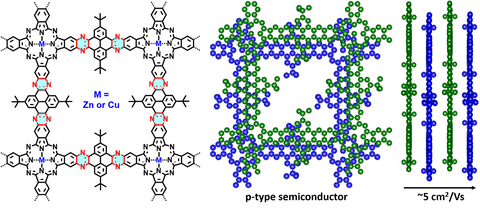Oct 22, 2019
Unveiling Electronic Properties in Metal-Phthalocyanine-based Pyrazine-linked Conjugated Two-Dimensional Covalent Organic Frameworks
Conjugated two-dimensional (2D) covalent organic frameworks (COFs), also termed as 2D conjugated polymer frameworks, have also been rising as active semiconductors for potential applications in optoelectronics, photovoltaics, chemiresistive sensing, and (photo)electrocatalysis. To date, improved electronic properties in π-conjugated 2D COFs have been achieved by systematic engineering of the framework favoring extended conjugation, e.g., by employing conjugated linkers such as carbon-carbon bonds and pyrazine units. Besides conjugated linkers, planar conjugated building blocks such as pyrene, porphyrin, hexabenzocoronene and phthalocyanine have been employed with the aim of improving mobilities. Although the recent developments illustrate that improved charge transport properties are at reach by rational tuning of COF structures, current approaches are generally unable to establish a neat relationship between the structure and electronic properties. To do so, a thorough analysis of intrinsic and extrinsic factors affecting the charge transport is highly required for π-conjugated 2D COFs where differential analysis is feasible (i.e., where changes in composition are not dramatically affecting the energy band diagram).
In order to address these challenges, researchers from Technical University of Dresden (Chair for Molecular Functional Materials) and collaborators have developed two novel pyrazine (pz)-linked metal-phthalocyanine (MPc)-based conjugated 2D COFs (MPc-pz, M = Zn or Cu), which assembled as van der Waals (vdWs) layer-stacked structures. The resultant materials are found to be polycrystalline p-type semiconductors with band gaps of ~1.2 eV. Van der Pauw, Hall effect, time-resolved terahertz spectroscopy (TRTS), and density functional theory (DFT) calculations are employed for characterizing univocally the intrinsic and extrinsic factors determining the electronic properties of these materials. We demonstrate that for this p-type semiconductor changing the metal center from Cu to Zn in the phthalocyanine moiety has a negligible effect in the conductivity, charge density, charge carrier scattering rate, and effective mass of majority carriers (holes). Mobilities up to ~5 cm2/(Vs) are resolved in the dc limit, which is limited by long-range charge carrier transport across crystalline grain boundaries. Interestingly, charge transport is found to be highly anisotropic, with hole mobilities being practically null in-plane and finite out-of-plane for the developed 2D COFs.
This work is financially supported from EU Graphene Flagship, ERC Consolidator Grant (T2DCP), Coordination Networks: Building Blocks for Functional Systems (SPP 1928, COORNET) as well as the German Science Council, Center of Advancing Electronics Dresden, EXC1056, (cfaed) and OR 349/1. We acknowledge Dresden Center for Nanoanalysis (DCN) at TUD; Dr. Philipp Schlender, Dr. Konrad Schneider (Leibniz Institute for Polymer Research, IPF, Dresden), Dr. Tilo Lübken and Mr. Friedrich Schwotzer for the use of facilities. We also appreciate Mr. Ji Ma, Dr. Haixia Zhong, and Ms. Yu Zhang (UvA) for the MS, SEM and XPS analysis, respectively. We thank Mr. Chi Xu (HZDR), Dr. Chongqing Yang and Dr. Zhongquan Liao (IKTS) for the helpful discussions. Prof. T. Heine and Hung-Hsuan Lin acknowledge the Centre for Information Services and High-Performance Computing (ZIH) in Dresden, Germany for the provided computational resources.
Reference:
Mingchao Wang, Marco Ballabio, Mao Wang, Hung-Hsuan Lin, Bishnu P. Biswal, Xiaocang Han, Silvia Paasch, Eike Brunner, Pan Liu, Mingwei Chen, Mischa Bonn, Thomas Heine, Shengqiang Zhou, Enrique Cánovas*, Renhao Dong*, Xinliang Feng*. Unveiling Electronic Properties in Metal-Phthalocyanine-based Pyrazine-linked Conjugated Two-Dimensional Covalent Organic Frameworks. J. Am. Chem. Soc.2019, DOI: 10.1021/jacs.9b07644.

